Roof rails for the kitchen: varieties, tips for choosing and installing
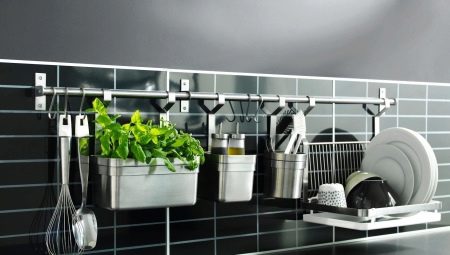
The kitchen rail is a uniquely simple design that can easily replace an entire cabinet or rack. In addition to its practical use, this at first glance unpretentious construction gives the kitchen a stylish look and a complete look.
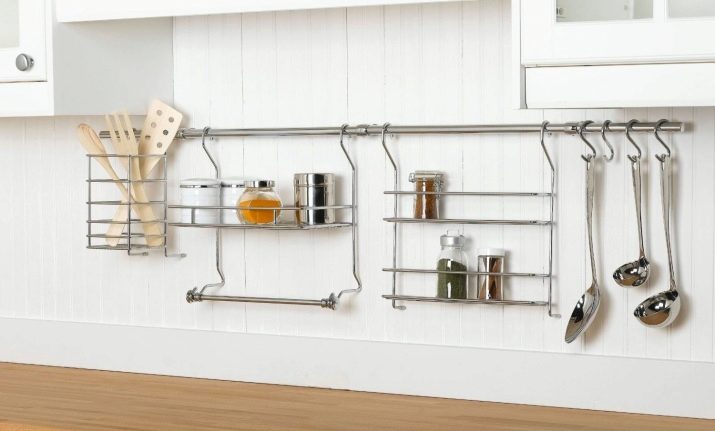
Peculiarities
A kitchen railing is a hollow tube with a round, rectangular or square cross section, which is attached to a wall, countertop or ceiling using several holders. The number of brackets depends on the length of the rod and can reach 3 or more pieces. The diameter of round rods is usually 16 mm, which is the most convenient size and allows you to easily place all kinds of clothespins and clamps on the pipes. As for the length of the rails, it ranges from 40 cm to 3 m, and the most common models are 60, 80, 100 and 120 cm long. mud.
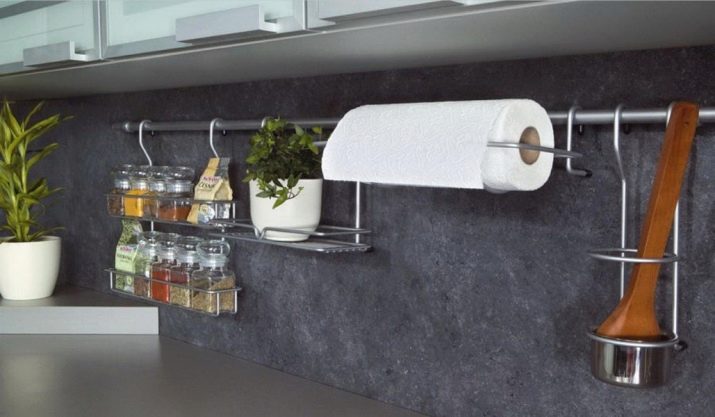
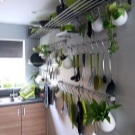
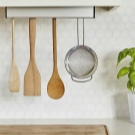



For the corner connection of two guides, special adapters equipped with couplings are used, and the junction itself is masked with a holder bracket.
Initially, roof rails were widely used in bars, restaurants and other catering establishments, where they successfully solved the problem of lack of space and helped to more efficiently use the available space. At the same time, all the items of kitchen utensils necessary for the personnel were at arm's length.A little later, roof rails came to home kitchens, where they were appreciated by housewives and firmly entered into use. The high consumer demand for kitchen roof rails is due to the following undeniable advantages of these simple designs:
- due to its high mobility, the bar can be installed in any part of the kitchen, regardless of the size of the room and the arrangement of furniture;
- the possibility of hanging multi-tiered storage systems on the railing eliminates the need to purchase bulky kitchen shelves and cabinets;
- a wide variety of accessories and rich equipment turn an ordinary pipe into a multifunctional and convenient structure, because, in addition to kitchen utensils, there are many other necessary things on the railing;
- removable hinged fittings allow you to swap items at your discretion and move them to other parts of the kitchen;
- the use of a roof rack significantly saves space on the desktop and relieves it of the presence of numerous small objects, which helps to maintain an exemplary order in the kitchen and visually increases the space;
- as mentioned above, the railing is able to replace a small kitchen cabinet, but, unlike the latter, it is very easy to clean, because if you need to completely empty all the shelves and thoroughly rinse every corner to wash the cabinets, then in order to wash the railing, it is not necessary to remove the hanging ones there are objects on it, for this it is enough just to move them first to one and then to the other side and wash the bar;
- thanks to its aesthetic design and use for the production of beautiful materials, the roof rail fits perfectly into any kitchen interior and gives it a special elegance;
- the design of the roof rails is so simple that it will not be difficult to install it even for an inexperienced person;
- the surface of the roof rails is highly resistant to moisture and chemicals, and the products themselves are distinguished by a long service life and overall structural reliability; the rods do not deform under high loads and retain their original shape throughout the entire period of operation.
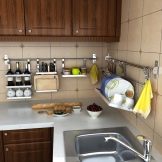
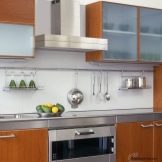

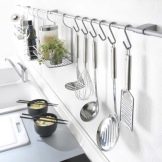
The disadvantages of kitchen rails include an aesthetic moment: the fact is that not all housewives like it when all kitchen utensils hang in plain sight, and prefer to use traditional cabinets. Another disadvantage is the need to punch holes in the wall or ceiling in order to secure the brackets.
Appointment
The main purpose of the roof rails is the correct organization of the storage system for kitchen utensils, from dishes to flowers and textiles. When using traditional cabinets, small items clutter up the shelves, making it often difficult to find the item you need quickly. Roof rails, on the other hand, allow you to accurately determine the location of an object, since they are constantly in sight and clearly recorded by visual memory.
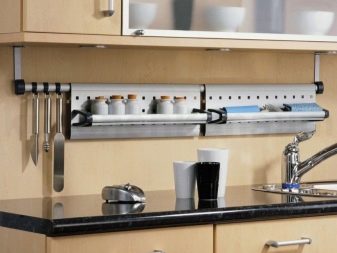
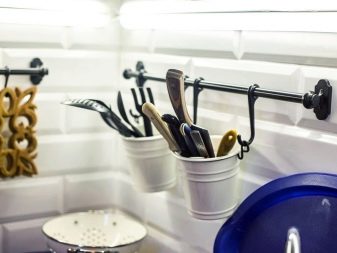
In addition, the roof rails significantly relieve the load of dining and cutting cabinets, since with certain accessories, even napkins and jars of spices can be hung on the chimney.
Items are placed on the bar using attachments - hooks, clothespins, mesh shelves, glass holders, dryers, towel racks and magnets. The listed accessories can turn an ordinary bar into a full-fledged storage system for kitchen utensils and allow you to solve the problem of placing graters, ladles, cutlery, lids, colander, shovels, tea towels, bread boxes, glasses, plates, mugs, scissors, fruit baskets, table napkins and other necessary items.
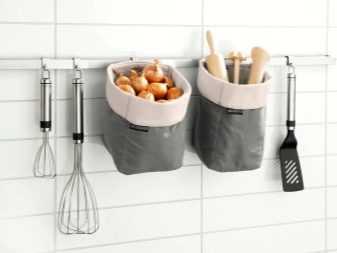
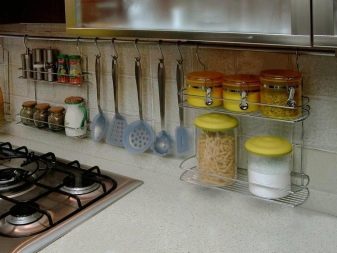
Views
There are several types of roof rails.
- Vertical. Such designs assume a vertical bar arrangement and are fixed between the ceiling and table top, ceiling and floor, as well as between the table and a hanging shelf or cabinet. All sorts of devices for storing objects are located on them, they are often given a separate corner. Such options look good in spacious rooms, where they often act as an independent design element. The vertical railing also looks good on the bar counter, accommodating glasses and glasses.
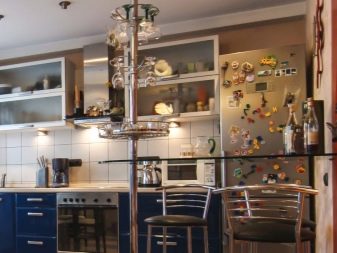

- Horizontal. Such roof rails represent the most numerous group of products and are very popular in home kitchens. The rods are of different lengths and can be located near one wall or surround the kitchen around the perimeter. Such models are often equipped with a multi-tiered storage system that allows you to fit a large amount of kitchen utensils in a limited space. Horizontal models are often placed under cabinets and are equipped with a large number of hooks and mesh shelves, which leads to an ergonomic use of space and saves space in the cabinets.
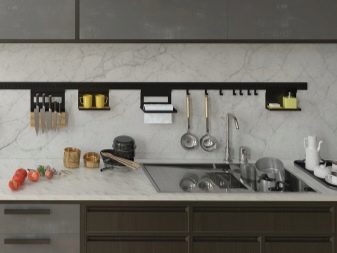

- Suspended models. Such structures are located above the work table, kitchen island or bar counter. They are used to accommodate cooking utensils, dishes and glasses. The only condition for placing hanging rails is to move them away from the slab. Otherwise, fumes and drops of fat will settle on the utensils and quickly contaminate them.
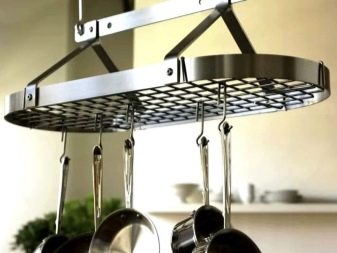

Materials (edit)
For the manufacture of roof rails, materials such as brass, anodized aluminum and stainless steel are used. To give the products a modern look, the metal rods are plated with chrome and nickel. The chrome-plated surfaces are perfectly combined with the majority of modern trends and fit well into the space. For lovers of retro styles, the modern manufacturer offers a huge number of models for gold, copper and bronze.
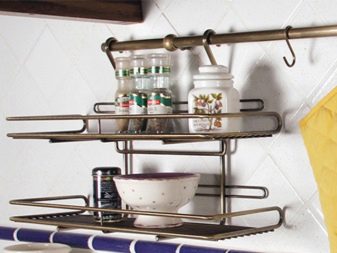
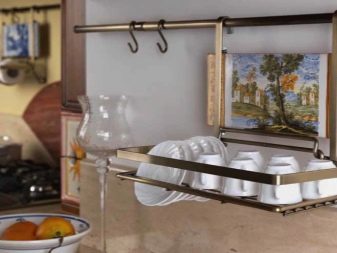
Among them you can see artificially aged specimens with patinated surfaces, which most accurately convey the spirit of that time.
As for the strength of the material, the "stainless steel" holds the palm. Steel products do not bend or deform, do not corrode and can serve for 10 or more years. Anodized aluminum is much lighter than rolled steel, but more vulnerable to serious weight loads. Therefore, the use of this material is often limited to the production of short products, which, due to their low cost, are in high demand. Brass is also used in the production of roof rails and looks very nice. Its only drawback is the high price and the need for regular maintenance. The latter requirement is due to the tendency of brass to darken and become cloudy over time.
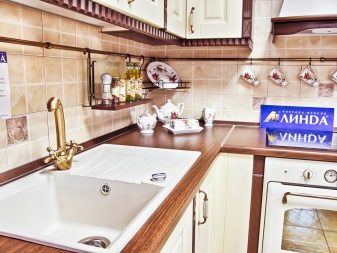
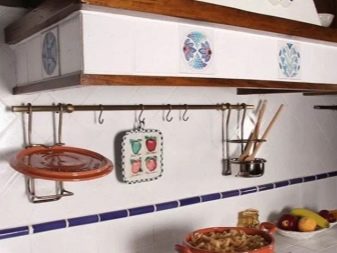
In addition to metal, impact-resistant glass is often used in the production of roof rails. Such models are often equipped with internal lighting, and the glass can be transparent, matte or multi-colored. And also there are models with wood and plastic inserts. They look very original and, thanks to a wide range of colors and a variety of designs, are easily matched to any artistic look of the kitchen.

Color solutions
Most roof rails on the market today have a chrome or nickel finish that makes the surface of the rod mirrored. Such models are especially popular among consumers due to their compatibility with most interiors. Often, products are equipped with multi-colored plugs, inserts and decorative elements., which allows you to match them to the color of household appliances, walls or kitchen furniture.
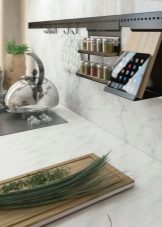
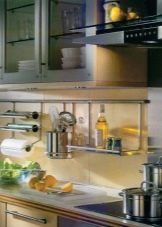

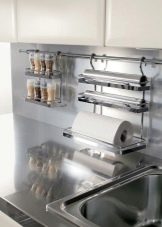
The most common roof rails, which include black, white or red details, are ideal for most modern interiors.
Manufacturers overview
The modern kitchen accessories market offers a huge selection of roof rails. Among them there are both models of eminent companies and products of unknown enterprises. Below are the most famous manufacturers that produce a wide range of roof rails with a wide variety of sizes, shapes and designs.
- Tescoma from the Czech Republic has been on the market for a long time. A distinctive feature of the products is the excellent quality of products and a wide price range. All models have a beautiful design and are available in both matte and glossy versions. The cost of the simplest compact railing without accessories starts at 300 rubles.
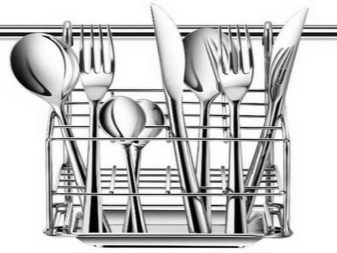
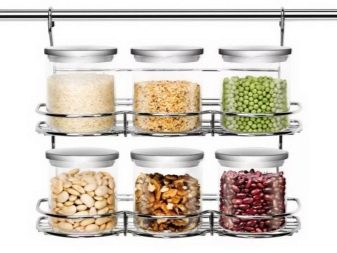
- Kessebohmer from Germany has been specializing in the production of kitchen equipment for several decades. The company produces railing structures with round and square sections, as well as a huge number of attachments. The German manufacturer uses the latest galvanic technology to keep the mirror surface in perfect condition for a long time. In addition to glossy chrome and nickel, the product catalog contains items with decorative coatings "matt chrome", "matt nickel" and "bright gold". The cost for German models is quite adequate. The most budgetary railing of the Kessebohmer company will cost the buyer 900 rubles.
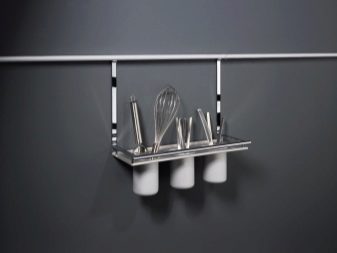
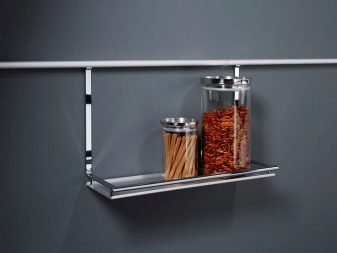
- Lemi from Italy produces inexpensive roof rails with bronze, copper, matt chrome and glossy chrome surfaces. The undoubted advantage of Italian products is a wide range and low cost. The disadvantages include not too high-quality spraying, which wears out quickly and leads to the loss of the original gloss. The most inexpensive railing with a bronze coating from the Lemi company can be bought for 390 rubles, while a chrome model in a matte finish will cost 550 rubles.

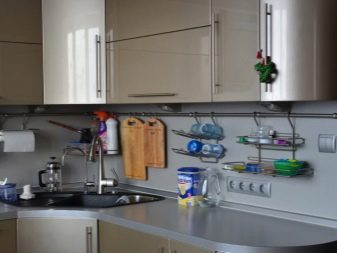
- Has proven itself well and products from China... As an example, consider a company called Lemax, which is the leader in the sales of kitchen rails in Russia. Compatriots choose Chinese products for low cost, rich equipment and attractive appearance. Models are often decorated with colored glass, plastic and wood inserts, and some of them are equipped with interior lighting. In addition, some products are attached to the surface with suction cups, which allows you not to spoil the walls with unnecessary holes. The cost of the most budget model without attachments is 350 rubles.
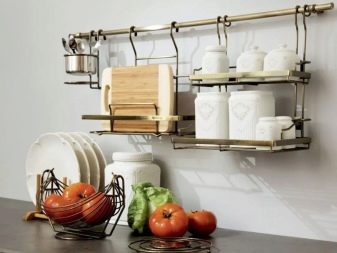
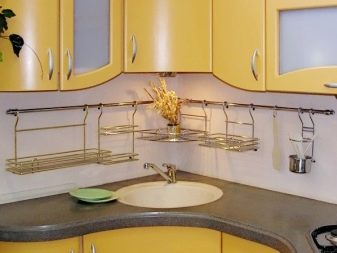
How to choose?
When choosing roof rails, it is necessary to take into account a number of important points. The length of the purchased rail must be commensurate with the size of the kitchen. In small rooms, several compact models are quite enough, for example, for a kitchen with an area of 12 m², two roof rails 60 cm long will be quite enough. Otherwise, there is a risk of overloading the space and creating difficulties in cleaning.
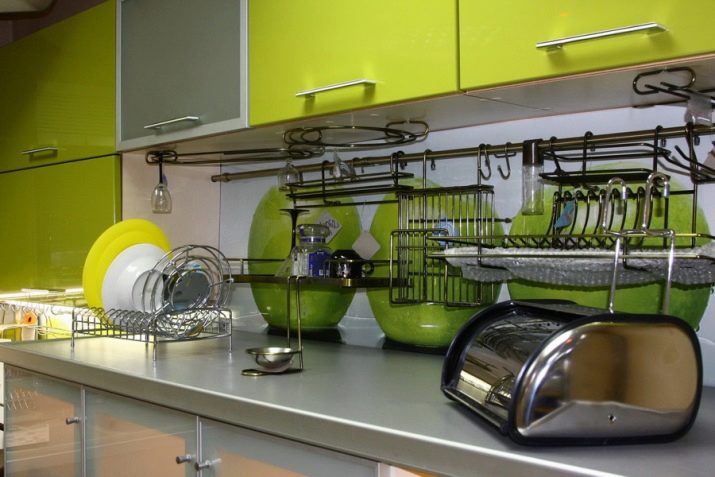
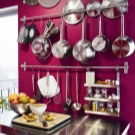

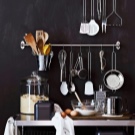
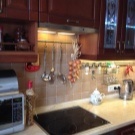
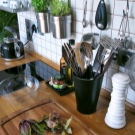
The choice of attachments should be a matter of need and common sense. You do not need to purchase too many different holders, hooks and shelves, since only those items that are used daily should be on the railing. If, for example, confectionery is baked every six months, then keeping baking dishes close at hand does not make sense. And it is also not recommended to purchase and place holders on the bar in reserve, and even more so hang them with a large number of mugs. Excess items will cause visual clutter of the space, and the railing will lose its sophistication and aesthetics.
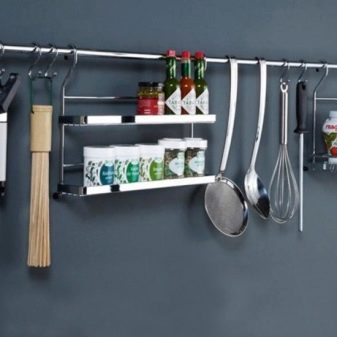
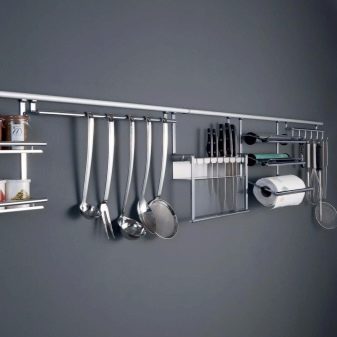
The roof railing system should fit well into the overall style and not look like something foreign in it. To do this, you should understand that the color of the bar, attachments and holders should be in harmony with kitchen furniture fittings, plumbing fixtures, household appliances or a hood. Models of matte copper, gold and bronze tones, as well as products with elements of forging, are well suited for classic, rustic and country interiors. In a loft-style kitchen, black roof rails will look good, and for the Scandinavian direction, minimalism and high-tech - strict flat designs without any special artistic delights in a glossy or matte finish.
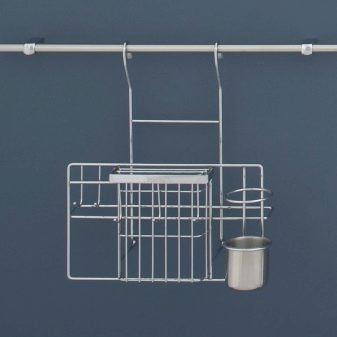
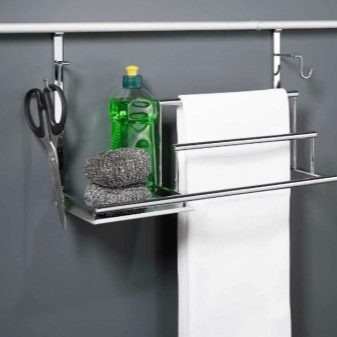
Where to locate?
When choosing a place for the railing, it is advisable to follow some rules. So, the most spacious corner models are best placed near the sink. In addition to linear options, the use of multi-tiered structures is appropriate., which will allow placing on them not only dishes and cutlery, but also detergents, sponges and paper towels. However, this arrangement is only suitable for spacious kitchens. In small rooms, multi-tiered and overly cluttered roof rails create a feeling of crowding, bedlam and clutter. For small-sized kitchens, one short model is quite enough, on which several spatulas or a compact dish drainer are hung.
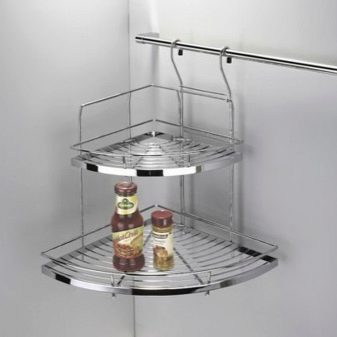
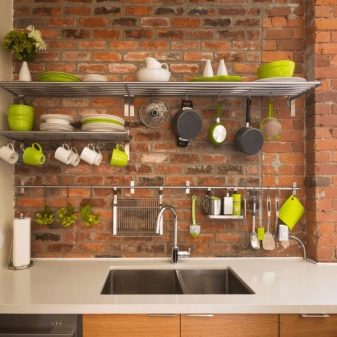
In the area of the slab, the installation of compact horizontal structures will be justified., which are the best fit for placing kitchen utensils, salt, lighters, potholders and seasonings - in short, everything that may be needed in the cooking process. It is good to place short rails on the ends of countertops, on the side surfaces of "kitchen islands" and on the side walls of wall cabinets. The rails can also be used for closed storage systems, located on the inside of the doors of pedestals and cabinets.


For this, small models are used, which are selected in accordance with the size of the furniture, and are used for rarely used utensils.
An interesting solution would be the location of the roof rails at different heights in the form of broken lines. This will allow zoning the space and emphasizing the geometry of the kitchen. An equally unusual option would be the location of the roof railing systems in the recreation areas of dining rooms and large kitchens. Usually, for these purposes, vertical structures from floor to ceiling are used, on which kitchen textiles, wicker baskets for various trifles and other pleasant things are placed. You can also position the rail near the coffee machine, equipping with it a home coffee bar. When placing the structure above the bar, it is advisable to hang only glasses and bottle holders on it, since there is absolutely no place for other kitchen utensils in such places.
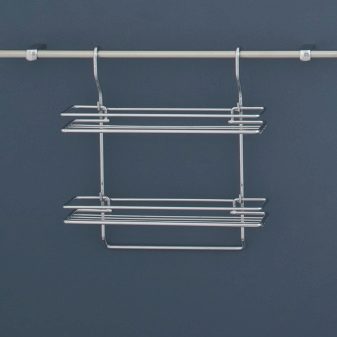
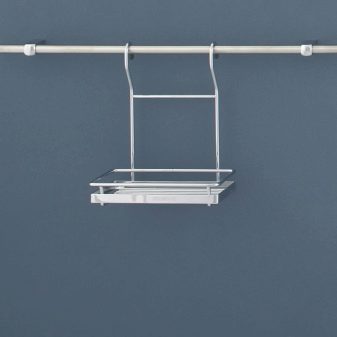
How to choose the height and install?
The rails should be installed in such a way that the objects located on them are always at hand, and you do not have to reach for them. So, if the horizontal structure is installed above the table, then the distance from the crossbar to the countertop should be 40-50 cm. If the storage system will be located on a kitchen apron under a wall cabinet, then at least 8-10 cm should be spaced from its bottom panel. Roof rails can be attached to any surface, including painted, papered and tiled walls. The only exceptions are kitchen aprons made of extra strong glass. In such cases, the installation of the roof rails is carried out before the installation of the apron, and in cases where this is not possible, models with suction cups are used.
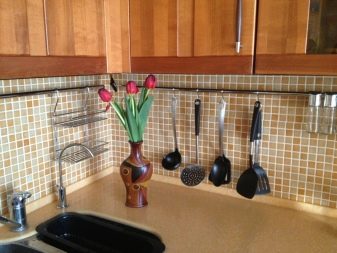

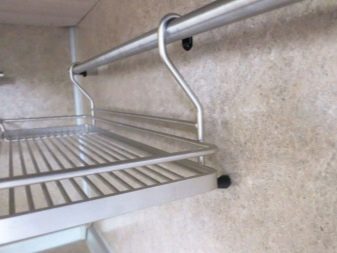

Important! It should be remembered that for a more reliable fastening of the rod, the holders should be located every 50 cm. Otherwise, the fasteners will be considered weak and the railing will not be able to load as much as possible.
The installation process itself is quite simple and consists of such sequential stages as:
- using a laser level, marking is made, while the start and end points, as well as several intermediate points are marked on the surface;
- holes with a diameter of 6 to 8 mm are drilled in the marked areas, intended for fastening the holders; if work is carried out on tiles, it is recommended to use special drills for tiles;
- plastic plugs are installed in the holes made, which come with the rails, and support bushings are attached to them with self-tapping screws;
- the holders are put on the support pins, after which the rods are inserted and fixed; if the bar is too long, it needs to be shortened, use a hacksaw for metal;
- the ends of the pipes are closed with decorative plugs consisting of a connecting screw, a protective cap and a coupling;
- if necessary, angular installation use special connectors, which are an arc with an angle of 90 or 135 degrees;
- installation of vertical rails is made in the spacer - for this, the models have an additional rod, which extends according to the principle of a telescope to the required length; instead of plugs, plastic or silicone pads are used to prevent damage to the supporting surfaces.
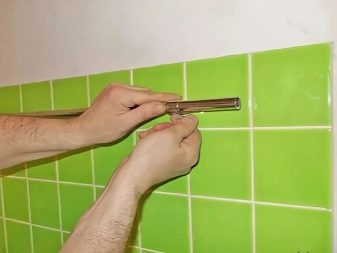



Advice
To make the use of the railing as convenient and comfortable as possible, you can use simple guidelines.
- To save space on the bar, it is better to put small items in one glass or basket, rather than hang them on separate hooks.
- It is better to store kitchen utensils by category and in specific places. So, it is better to place all the utensils necessary for cooking next to the stove, glasses and glasses - above the bar, mugs and cutlery - not far from the dining table, and beautiful textiles, wicker baskets and boxes using decoupage technique will find their place next to the seating area.
- The filling of the roof rails should also correspond to the style direction of the kitchen and not cause dissonance. So, checkered things are suitable for shabby chic, pot-bellied pots with fragrant herbs or voluminous jars of tea and coffee will perfectly fit into Provence. For retro interiors, an excellent solution would be to place wooden mills for salt and spices or patinated copper mortars.
- In order for the rail to last as long as possible and retain its original attractiveness, it must be properly looked after. To do this, it is enough to wipe it daily, first with a damp and then dry cloth, and perform general cleaning with neutral detergents. In this case, use the softest sponge that does not leave scratches on the chrome-plated surface. The use of abrasive cleaning agents is not permitted for the same reason. It is better to use regular dishwashing liquid, which will not only give the metal surface its original shine, but also dissolve the frozen drops of fat.
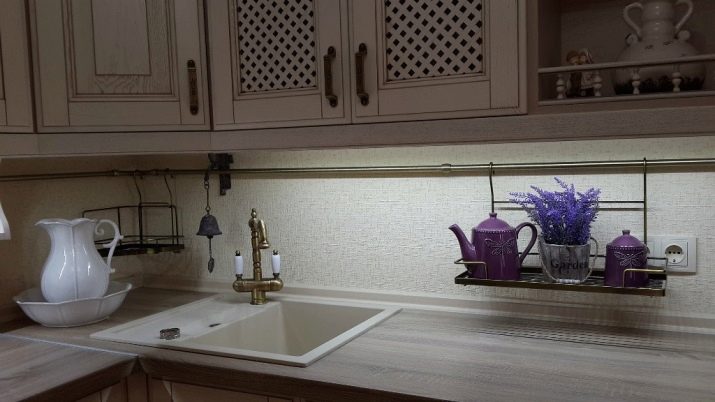
Beautiful examples in the interior
Besides the practical function, kitchen rails are highly decorative and can significantly transform even the most boring interior.
- The long rail above the work area gives the kitchen a sophisticated and modern look.

- The corner structure is very spacious and functional.
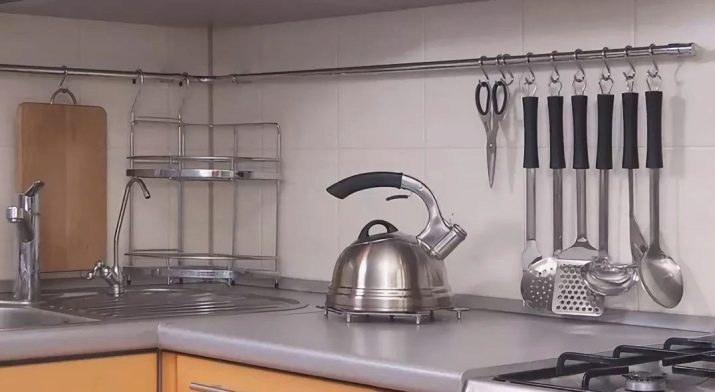
- The black model looks great in the loft style.

- The hanging rail above the kitchen island is compact and functional.

- The vertical construction to the ceiling is a great addition to the bar counter.

For information on how to install kitchen rails, see the next video.








